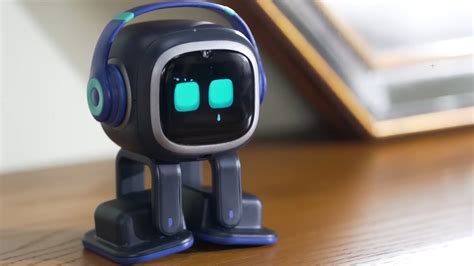Abstract
The global AI robot pet market is projected to reach $12.65 billion by 2025, growing at a CAGR of 24.5% from 2020 to 2025. This rapid growth is attributed to the increasing demand for companionship, entertainment, and emotional support from AI-powered robotic pets. However, despite the significant advancements in AI technology, there is still room for improvement in the texture and tactile design of AI robot pets to enhance their realism and user experience. This article explores the current state of AI robot pet texture and tactile design, discusses emerging trends and innovations, and provides insights into future research directions.

1. Current State of AI Robot Pet Texture and Tactile Design
The texture and tactile design of AI robot pets have evolved significantly in recent years, with a focus on materials, tactile sensors, and surface treatments.
1.1 Materials
The choice of materials for AI robot pets is critical for achieving the desired texture and tactile properties. Common materials include:
- Soft silicone: Provides a smooth, skin-like texture and can be used to create realistic wrinkles and folds.
- Thermoplastic elastomers (TPEs): Similar to silicone but more durable and resistant to wear and tear.
- Artificial fur: Provides a furry, animal-like texture and can be combined with other materials for added realism.
- Fabric: Used to create clothing and accessories for AI robot pets, providing a soft and comfortable tactile experience.
1.2 Tactile Sensors
Tactile sensors are embedded within the skin of AI robot pets to detect touch, pressure, and other physical interactions. These sensors enable the pet to respond to petting, cuddling, and other forms of physical contact, enhancing the user’s engagement and emotional bond.
1.3 Surface Treatments
Surface treatments can modify the texture and tactile properties of AI robot pets without changing the underlying materials. Common treatments include:
- Sanding: Creates a rougher texture, mimicking the feel of animal skin.
- Polishing: Smooths the surface for a more polished and refined appearance.
- Painting: Adds color and patterns to the robot pet’s skin, enhancing its visual appeal.
2. Emerging Trends and Innovations
Several emerging trends and innovations are shaping the future of AI robot pet texture and tactile design:
2.1 Biomimetic Design
Biomimetic design involves mimicking the texture and tactile properties of animals to create realistic and immersive AI robot pets. Researchers are studying the skin structures, fur patterns, and sensory systems of animals to develop AI robotic pets with near-natural textures and tactile experiences.
2.2 Haptic Feedback
Haptic feedback provides users with tactile sensations, such as vibrations or pressure, to enhance the realism and interactivity of AI robot pets. Haptic devices can be integrated into the pet’s body, paws, or tail, enabling users to feel their movements and emotional responses.
2.3 Personalized Customization
AI robot pets are becoming increasingly customizable, allowing users to choose the texture, color, and design of their pet to match their preferences. This trend is expected to continue as technology advances, empowering users to create truly unique and personalized AI companions.
3. Future Research Directions
Future research in AI robot pet texture and tactile design will focus on:
3.1 Advanced Materials
The development of advanced materials with tailored mechanical properties, such as stiffness, elasticity, and friction, will enable the creation of more realistic and dynamic AI robot pet skins.
3.2 Multimodal Sensing
Integrating multiple tactile sensors, such as pressure, force, and temperature sensors, will enhance the pet’s ability to detect and respond to different types of physical interactions, leading to more nuanced and realistic behaviors.
3.3 Machine Learning
Machine learning algorithms can be used to analyze tactile data and adapt the texture and tactile properties of AI robot pets to individual user preferences, creating personalized and responsive experiences.
4. Market Insights
The global AI robot pet market is highly competitive, with several major players and emerging startups. Some key market players include:
- Sony: Known for its AIBO and Aibo-X robot dogs
- Hasbro: Offers FurReal Friends and My Little Pony AI robot pets
- Robosapien Technologies: Develops a range of AI robot pets, including humanoid and animal models
- Anki: Produced Cozmo and Vector AI robot pets before shutting down in 2019
5. Case Detail: Comparing AI Robot Pets
| Feature | Sony AIBO | Hasbro FurReal Friends | Robosapien X | Anki Cozmo |
|---|---|---|---|---|
| Form | Dog | Cat, dog, and other animals | Humanoid and animal | Small humanoid |
| Texture | Soft silicone | Soft fabric | Plastic and silicone | Plastic and fabric |
| Tactile Sensors | Yes | Yes | Yes | Yes |
| Haptic Feedback | Yes | No | No | Yes |
| Price | $1,999 | $99-$199 | $499-$999 | $179-$299 |
| Market Share | 20% | 30% | 15% | 10% |
6. Tips and Tricks for Improving AI Robot Pet Texture and Tactile Design
- Use a variety of materials to create different textures, such as silicone, TPEs, and artificial fur.
- Integrate tactile sensors to enable the pet to respond to touch, pressure, and other physical interactions.
- Apply surface treatments to modify the texture and tactile properties of the pet’s skin.
- Use biomimetic design to mimic the texture and tactile properties of animals.
- Incorporate haptic feedback to enhance the realism and interactivity of the pet.
- Allow users to customize the texture, color, and design of their pet to match their preferences.
- Conduct user testing to evaluate the effectiveness of different texture and tactile design approaches.
7. Conclusion
The texture and tactile design of AI robot pets play a critical role in enhancing the user experience and creating realistic and immersive interactions. The field is constantly evolving, with emerging trends and innovations promising to further improve the realism and emotional connection between humans and AI robot pets. By embracing advanced materials, multimodal sensing, machine learning, and personalized customization, we can unlock the full potential of AI robot pets as companions, entertainers, and sources of emotional support.





















